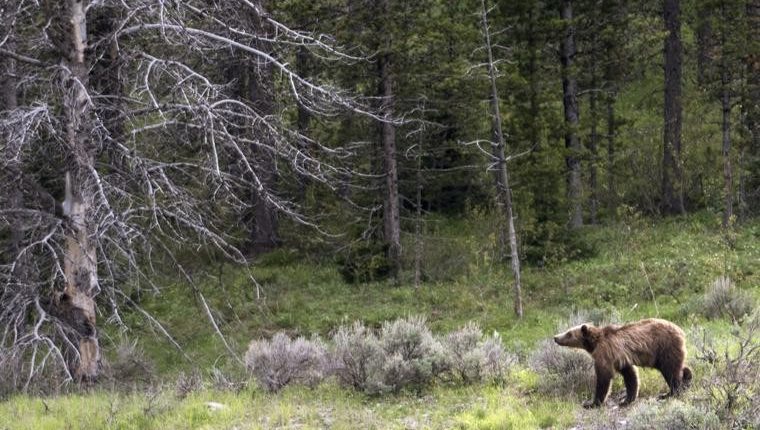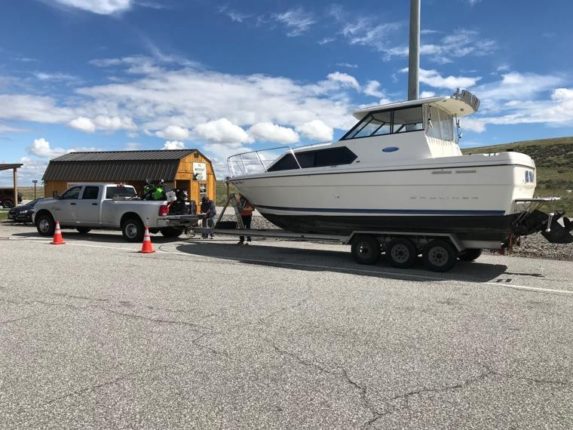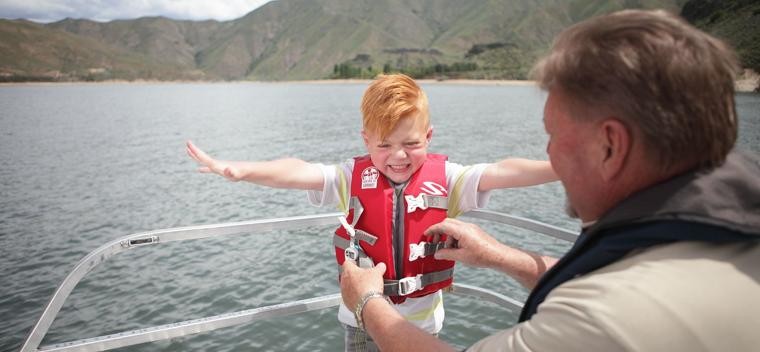Summer is upon us, leading many to escape to the mountains to relax and camp. Before you head to the hills, Fish and Game wildlife biologists remind everyone to be mindful of wildlife, especially bears, when camping over the Fourth of July holiday and …
Category: Outdoors
How to camp safely in bear country and avoid unwanted encounters
Summer is upon us, leading many to escape to the mountains to relax and camp. Before you head to the hills, Fish and Game wildlife biologists remind everyone to be mindful of wildlife, especially bears, when camping over the Fourth of July holiday and …
Department of Ag offers tips on preventing invasive species on watercrafts
So far this year, the Idaho State Department of Agriculture has performed more than 45,000 watercraft inspections looking for invasive species. In those inspections, 35 mussel-fouled watercraft carrying dead, non-viable mussels have been found.
The inspections, with are in its 11th season, are done to prevent spreading invasive species such as quagga and zebra mussels.
Before launching on Idaho waters, all watercraft must have a current invasive species sticker, which is sold by the Idaho Department of Parks and Recreation at many locations across the state.
“Keeping Idaho’s waterways free from invasive species requires the diligence of all boat owners, including non-motorized vessels,” said Jennifer Okerlund, communications manager for the IDPR. “Idaho law states that any motorized or non-motorized boat operating in Idaho is required to display an Invasive Species Fund sticker. Only inflatable, non-motorized vessels that are less than 10 feet in length are exempt from this requirement.”
Tips for avoiding the growth of invasive species on a watercraft include:
- Clean watercraft and equipment before leaving any body of water. Clean watercraft, anchors, planes, trailers, waders, shoes, and gear for visible plants and pests. Dispose of material on-site in a trash can or on high, dry ground where there is no danger of it washing into water.
- Drain water from all equipment, including motors, live wells, sea strainers, wakeboard ballast tanks, boat hulls, scuba gear, bait buckets and boots. Pull the boat’s bilge plug and allow water to drain.
- Dry all vessel compartments and lay equipment out to dry before using in a different body of water.
The ISDA operates 20 watercraft inspection stations positioned at important corridors into Idaho. The program also includes six roving inspection teams. Law enforcement officers also play a role in the watercraft inspection program and have turned back nearly 1,000 vehicles traveling with boats or watercrafts.
“We’ve worked hard on this program but we certainly haven’t worked alone,” said ISDA Director Celia Gould. “We are very grateful for committed cooperators, law enforcement service, strong legislative backing, and the support of important partners such as Idaho Power. A collaborative approach is the only option for a threat of this magnitude.”
Watercraft users are required by law to stop for inspection when traveling past an Idaho invasive species station during operating hours.
The ISDA operates a hotline at 877-336-8676 for anyone needing information or a free decontamination wash for watercraft that may have been in mussel-infested waters. More information on the operation of inspection stations is available here.
Department of Ag offers tips on preventing invasive species on watercrafts
So far this year, the Idaho State Department of Agriculture has performed more than 45,000 watercraft inspections looking for invasive species. In those inspections, 35 mussel-fouled watercraft carrying dead, non-viable mussels have been found.
The inspections, with are in its 11th season, are done to prevent spreading invasive species such as quagga and zebra mussels.
Before launching on Idaho waters, all watercraft must have a current invasive species sticker, which is sold by the Idaho Department of Parks and Recreation at many locations across the state.
“Keeping Idaho’s waterways free from invasive species requires the diligence of all boat owners, including non-motorized vessels,” said Jennifer Okerlund, communications manager for the IDPR. “Idaho law states that any motorized or non-motorized boat operating in Idaho is required to display an Invasive Species Fund sticker. Only inflatable, non-motorized vessels that are less than 10 feet in length are exempt from this requirement.”
Tips for avoiding the growth of invasive species on a watercraft include:
- Clean watercraft and equipment before leaving any body of water. Clean watercraft, anchors, planes, trailers, waders, shoes, and gear for visible plants and pests. Dispose of material on-site in a trash can or on high, dry ground where there is no danger of it washing into water.
- Drain water from all equipment, including motors, live wells, sea strainers, wakeboard ballast tanks, boat hulls, scuba gear, bait buckets and boots. Pull the boat’s bilge plug and allow water to drain.
- Dry all vessel compartments and lay equipment out to dry before using in a different body of water.
The ISDA operates 20 watercraft inspection stations positioned at important corridors into Idaho. The program also includes six roving inspection teams. Law enforcement officers also play a role in the watercraft inspection program and have turned back nearly 1,000 vehicles traveling with boats or watercrafts.
“We’ve worked hard on this program but we certainly haven’t worked alone,” said ISDA Director Celia Gould. “We are very grateful for committed cooperators, law enforcement service, strong legislative backing, and the support of important partners such as Idaho Power. A collaborative approach is the only option for a threat of this magnitude.”
Watercraft users are required by law to stop for inspection when traveling past an Idaho invasive species station during operating hours.
The ISDA operates a hotline at 877-336-8676 for anyone needing information or a free decontamination wash for watercraft that may have been in mussel-infested waters. More information on the operation of inspection stations is available here.
Idaho man climbs Mount Everest for 20th time
BOISE — In recent weeks, crowds of climbers attempting to conquer Mount Everest have made international headlines as several people died in “traffic jams” atop the tallest peak in the world.
Ang Dorjee Sherpa, a Boise resident, was there. He saw the lines of people at the top of the 29,029-foot peak. He made it to the summit and safely descended, and all members of the group he was leading accounted for.
Ang Dorjee, who works as a guide for New Zealand-based Adventure Consultants, estimates about 300 climbers were lined up at the summit on May 22, the same day a Utah man died of altitude sickness on the mountain. In the following days, eight other climbers died on Everest.
The Nepalese-born guide understood, perhaps better than almost anyone in the world, just how unusually crowded Everest was this spring. That’s because it was Ang Dorjee’s 20th trip to the summit.
“In 2013 was the busiest (I’d seen it),” Ang Dorjee told the Idaho Statesman in an interview just days after returning from Nepal. “This year got worse than that time.”
He said the traffic jams start just below the summit, where the route to the peak is very narrow.
“The ascending part is easy,” Ang Dorjee, 49, said. “A lot of people die on the way down. They don’t think about (when they’re at the top), they’re only halfway.”
SAFELY SUMMITING EVEREST
Everest is always risky, Ang Dorjee said. Which is likely why only four people have climbed the mountain more times than Ang Dorjee has. (“A lot of people ask me, ‘Do you want to go for a record?’ “ he said. “I’m not that interested in that.”)
The key to getting there and back safely, Ang Dorjee said, is to go with an experienced guide. In spite of the recent rash of deaths on the mountain and worries of overcrowding, Ang Dorjee said conditions on Everest are better now than they’ve been since he started climbing in the early 1990s.
“Compared to then, everything is better,” he said. “You can get internet and everything around Base Camp.”
Sophie Hilaire, a 31-year-old Army veteran from New York City, was part of the group Ang Dorjee was guiding in May.
“I remember meeting him for the first time on our trek to Everest Base Camp and being starstruck,” Hilaire wrote in an email. “I was thrilled to learn from and climb with an Everest legend!”
After spending seven weeks together, Hilaire said, she began to think of Ang Dorjee as a mentor and friend. He offered feedback and pointers, which Hilaire said made her a better mountaineer.
In addition, his deep roots in climbing and in Nepal were crucial.
“He played a really valuable role for our team as a guide and former Sherpa, often acting as the bridge between our Western guides/base camp team and our sherpas,” Hilaire said. “There aren’t a lot of Sherpas who are also Western guides. He’s a rarity.”
Ang Dorjee said there are a few things every Everest hopeful should know: They should have avalanche rescue training, know how to rappel, be aware of how to dress properly for the climb, have expertise in both ascending and descending, and train for the altitude on peaks around 23,000 to 24,000 feet.
Of course, there’s plenty more when it comes to being prepared for such a feat. But having an expert on your side doesn’t hurt.
“He was right next to me on our summit day, and I can’t describe how overwhelmed with gratitude I was as he led our team to the top of the planet,” Hilaire said.
ANG DORJEE’S MOUNTAINEERING BACKGROUND
Ang Dorjee grew up in Pangboche, Nepal, where his father led expeditions as a Sherpa, the Himalayan guides known for their mountaineering skills.
He started his mountaineering career as a teenager, when he would work as a porter on climbing expeditions. From there, he became a sirdar — the Sherpa in charge of managing all of the other Sherpas in an expedition.
“When I first started working with Ang Dorjee in 2000, he was a climbing sirdar, supervising the mountain staff, carrying loads, establishing camps, fixing ropes and ensuring the logistical pyramid was put in place; no easy task,” fellow Adventure Consultants guide Mike Roberts wrote in an email.
Roberts was part of Ang Dorjee and Hilaire’s group that summited in May.
Ang Dorjee was working as a sardar in May 1996 when his group was caught in a blizzard. The storm, known as the 1996 Mount Everest disaster, killed eight people. The trip was the basis for the 1997 book “Into Thin Air” and 2015 movie “Everest.”
Roberts said Ang Dorjee has a passion for climbing and “remains intrinsically driven to climb.”
“The high, icy realm of the Himalaya holds a compelling draw for him that is in many ways spiritual,” Roberts said. “When climbing with Ang Dorjee, I’ll often (hear) him reciting Buddhist chants and prayers, as an act of reverence and for safety and success.”
Hilaire noticed the same practice. She said it was a welcome part of the journey.
“Whenever I was next to him while we went through the (Khumbu) Icefall, I’d hear him praying. … It made me feel even more connected to the spiritual part of the journey, and safe,” Hilaire said.
Ang Dorjee moved to Eastern Washington in 2002 with his wife and two children. In 2014, he told the Tri-City Herald that he might retire from mountaineering after his 17th summit of Everest. Five years later, he’s still climbing.
“I keep saying, ‘A few more years,’ “ Ang Dorjee told the Statesman. “Why do I keep going back? I have a lot of family, siblings there.”
And leading an expedition means the opportunity to hire local Sherpas, an economic boon for the area.
“As the youngest member of his family, according to Sherpa tradition, Ang Dorjee is responsible to take care of his parents in their retirement, a responsibility he took seriously,” Roberts said. “Just last week when I was in Kathmandu with Ang Dorjee, he went to a series of schools paying fees for multiple nieces and nephews that he wishes to get a good education, and opportunities he never had.”
In 2016, Ang Dorjee moved to Boise. He’d been through the Treasure Valley while working as a wind turbine mechanic. He said he enjoyed seeing people hiking and biking in the Foothills when he visited.
He hasn’t spent much time in Idaho, as his adventure consulting work takes him all around the world. He’s spent some time in the Sawtooth mountains and enjoys mountain biking and hiking around Boise. But the terrain doesn’t compare to the Himalayas.
“I don’t really call them mountains,” Ang Dorjee said with a smile. “These are hills.”
18,000 rainbow trout to be stocked in Southeast Idaho in July
Grab your fishing pole, pack the cooler, and don’t forget your fishing license. Personnel from Idaho Fish and Game’s hatcheries in the Southeast Region will be releasing over 18,000 catchable-sized rainbow trout at the following locations during July. Fish on!
- Bannock Reservoir at the Portneuf Wellness Complex: July 1 to 5 (1,000 fish)
- Blackfoot River, below the dam and at Sage Hen, Cutthroat and Gaves campgrounds: July 1 to 5 (1,000 fish)
- Bloomington Creek: July 1 to 5 (200 fish)
- Cherry Creek: July 1 to 5 (100 fish)
- Crystal Springs Pond: July 1 to 5 (375 fish)
- Crystal Springs Pond: July 15 to 19 (375 fish)
- Cub River at Willow Flat Campground: July 1 to 5 (750 fish)
- Cub River at Willow Flat Campground: July 22 to 26 (500 fish)
- East Fork Rock Creek: July 8 to 12 (500 fish)
- East Fork Rock Creek: July 22 to 26 (500 fish)
- Eightmile Creek: July 1 to 5 (500 fish)
- Upper Kelly Park Pond: July 1 to 5 (250 fish)
- Mill Creek at Malad Summit Campground: July 1 to 5 (250 fish)
- Montpelier Creek: July 1 to 5 (500 fish)
- Montpelier Creek: July 22 to 26 (500 fish)
- Montpelier Rearing Pond: July 1 to 5 (250 fish)
- Montpelier Rearing Pond: July 22 to 26 (250 fish)
- Paris Creek: July 1 to 5 (250 fish)
- Pebble Creek: July 8 to 12 (500 fish)
- Portneuf River, below Pebble and above Lava Hot Springs: July 8 to 12 (1,250 fish)
- Portneuf River, below Pebble and above Lava Hot Springs: July 22 to 26 (1,250 fish)
- Portneuf River in Lava Hot Springs: July 8 to 12 (660 fish)
- Snake River at Three Layer Park and Pipeline Campground: July 15 to 19 (4,000 fish)
- Snake River at Tilden, Twin Bridges, Rose, Firth and Shelley: July 8 to 12 (2,000 fish)
- Toponce Creek: July 8 to 12 (1,000 fish)
18,000 rainbow trout to be stocked in Southeast Idaho in July
Grab your fishing pole, pack the cooler, and don’t forget your fishing license. Personnel from Idaho Fish and Game’s hatcheries in the Southeast Region will be releasing over 18,000 catchable-sized rainbow trout at the following locations during July. Fish on!
- Bannock Reservoir at the Portneuf Wellness Complex: July 1 to 5 (1,000 fish)
- Blackfoot River, below the dam and at Sage Hen, Cutthroat and Gaves campgrounds: July 1 to 5 (1,000 fish)
- Bloomington Creek: July 1 to 5 (200 fish)
- Cherry Creek: July 1 to 5 (100 fish)
- Crystal Springs Pond: July 1 to 5 (375 fish)
- Crystal Springs Pond: July 15 to 19 (375 fish)
- Cub River at Willow Flat Campground: July 1 to 5 (750 fish)
- Cub River at Willow Flat Campground: July 22 to 26 (500 fish)
- East Fork Rock Creek: July 8 to 12 (500 fish)
- East Fork Rock Creek: July 22 to 26 (500 fish)
- Eightmile Creek: July 1 to 5 (500 fish)
- Upper Kelly Park Pond: July 1 to 5 (250 fish)
- Mill Creek at Malad Summit Campground: July 1 to 5 (250 fish)
- Montpelier Creek: July 1 to 5 (500 fish)
- Montpelier Creek: July 22 to 26 (500 fish)
- Montpelier Rearing Pond: July 1 to 5 (250 fish)
- Montpelier Rearing Pond: July 22 to 26 (250 fish)
- Paris Creek: July 1 to 5 (250 fish)
- Pebble Creek: July 8 to 12 (500 fish)
- Portneuf River, below Pebble and above Lava Hot Springs: July 8 to 12 (1,250 fish)
- Portneuf River, below Pebble and above Lava Hot Springs: July 22 to 26 (1,250 fish)
- Portneuf River in Lava Hot Springs: July 8 to 12 (660 fish)
- Snake River at Three Layer Park and Pipeline Campground: July 15 to 19 (4,000 fish)
- Snake River at Tilden, Twin Bridges, Rose, Firth and Shelley: July 8 to 12 (2,000 fish)
- Toponce Creek: July 8 to 12 (1,000 fish)
Idaho Parks and Recreation reminds parents that state law requires kids to wear life vests
Officials from Idaho Department of Parks and Recreation would like to remind parents about Idaho’s life jacket law for kids. According to Idaho law, kids 14 years and younger are required to wear a life jacket on all vessels 19 feet or less, when the vessel is underway.
“County marine deputies have reported numerous instances around the state the past couple years where kids without life jackets are out boating with parents in small motor boats and paddle craft,” said David Dahms, IDPR boating program manager.
Idaho’s life jacket law applies to all vessels, including those with a motor and all paddle craft such as rafts, canoes, kayaks, stand-up paddleboards, row boats and drift boats. Dahms also notes that life jackets must be Coast Guard-approved and be properly fitted.
Kids without a life jacket may be in immediate danger if they fall in the water because of the year-round cold-water conditions prevalent in many of Idaho’s rivers and lakes. Adult operators of a vessel that do not comply with the kids’ life jacket law are subject to a $99 citation.
IDPR strongly encourages all kids and adults to wear a life jacket while boating on any sized vessel. For more information on how to properly fit a life jacket for a child or to get a listing of legally required safety information for your vessel, visit boatidaho.gov.
Idaho Parks and Recreation reminds parents that state law requires kids to wear life vests
Officials from Idaho Department of Parks and Recreation would like to remind parents about Idaho’s life jacket law for kids. According to Idaho law, kids 14 years and younger are required to wear a life jacket on all vessels 19 feet or less, when the vessel is underway.
“County marine deputies have reported numerous instances around the state the past couple years where kids without life jackets are out boating with parents in small motor boats and paddle craft,” said David Dahms, IDPR boating program manager.
Idaho’s life jacket law applies to all vessels, including those with a motor and all paddle craft such as rafts, canoes, kayaks, stand-up paddleboards, row boats and drift boats. Dahms also notes that life jackets must be Coast Guard-approved and be properly fitted.
Kids without a life jacket may be in immediate danger if they fall in the water because of the year-round cold-water conditions prevalent in many of Idaho’s rivers and lakes. Adult operators of a vessel that do not comply with the kids’ life jacket law are subject to a $99 citation.
IDPR strongly encourages all kids and adults to wear a life jacket while boating on any sized vessel. For more information on how to properly fit a life jacket for a child or to get a listing of legally required safety information for your vessel, visit boatidaho.gov.
Marine deputy who responded to double drowning says he sees boaters without life jackets nearly every day
Custer County Marine Deputy John Haugh sees boaters without life jackets on cold Sawtooth Mountain Range lakes nearly every time he takes his patrol boat out.
He issues warnings and citations to parents whose children are not wearing life jackets. He teaches water safety classes to schoolchildren, who often end up teaching their parents a thing or two. Tragically, despite his best efforts, not everyone gets the message.
Haugh was among the emergency responders last week who tried to save a 5-year-old girl from drowning on Redfish Lake. Claire Tanney and her father, Christopher Joseph Tanney, 31, an active duty serviceman stationed at Mountain Home Air Force Base, died after their kayak capsized on Redfish Lake on Friday.
Nobody saw the boat capsize or heard anyone call for help, said Haugh, even though hundreds of people were at the north shore day use area that includes Redfish Lake Lodge, beach and marina. Nobody knew anything bad had happened until someone on the beach saw a little girl floating face down just 25 feet from shore where the wind had blown her. The kayak was spotted later.
“This isn’t an isolated section,” Haugh said. “There were many people in the area. (A drowning) can happen so fast.”
A nurse practitioner and others on the beach immediately started CPR on the girl, Haugh said. The Custer County Sheriff’s Office was notified at 10:52 a.m. Friday.
Christopher Tanney drowned. His body sank and was recovered from the lake bottom in 44-foot-deep water not far off the north beach on Saturday, Haugh said. Claire was taken to St. Luke’s Wood River Medical Center in Ketchum on Friday where doctors got her pulse back and warmed her core. Then she was flown to St. Luke’s Boise Medical Center. She died in the hospital the next day. As far as Haugh knows, she never regained consciousness.
The Tanneys were not wearing life jackets. Claire’s was found in her father’s vehicle, Haugh said.
Haugh hopes the circumstances of the double drowning never happen again.
A shuttle boat driver from Redfish Lake Lodge saw Claire and Christopher leave in their kayak from the north shore beach about 10 a.m. Friday, Haugh said. After he dropped off hikers at the south end of the lake, the shuttle skipper headed back toward the lodge and saw the father-daughter pair also heading back.
Air temperature was in the 60s on Friday, and the water temperature was 54 degrees, Haugh said. Southerly winds were blowing between 10 and 15 mph, with gusts to 20 mph kicking up choppy waves 6 to 8 inches high.
Christopher and Claire were at Redfish for a father-daughter trip of camping, fishing and boating, Haugh said. Personnel at Mountain Home Air Force Base are handling funeral arrangements, he said. Press releases issued during the weekend by the Custer County Sheriff’s Office state the girl was 4.
Haugh gave kudos to the army of emergency responders and Jeff Clegg and staff at Redfish Lake Lodge, who fed and housed members of the Bingham County dive team free of charge. Idaho Department of Fish and Game personnel responded with a boat and helped Haugh and the Bingham County team search underwater with sonar for Christopher’s body.
The boats did a grid search Friday and resumed the search early Saturday morning. At 10:39 a.m. divers found and recovered Christopher’s body from the bottom of the lake near the swimming platform, which is not far offshore from the beach.
On Saturday, Haugh found a 7-year-old boy from Wood River Valley on Redfish Lake on a stand-up paddle board without a life jacket. He took the boy on board his patrol boat and got him to shore. The boy’s father didn’t know his son was out there, said Haugh, and hadn’t heard about the previous day’s double drowning. Haugh issued a citation. The father thanked Haugh for writing him up. The boy, also named John, gave Haugh a fist bump.
“People just don’t know how fast kids can disappear,” Haugh said.
Idaho law requires children 14 and younger to wear life jackets on boats less than 19 feet long. On larger boats, there must be a readily accessible life jacket on board for every person.




